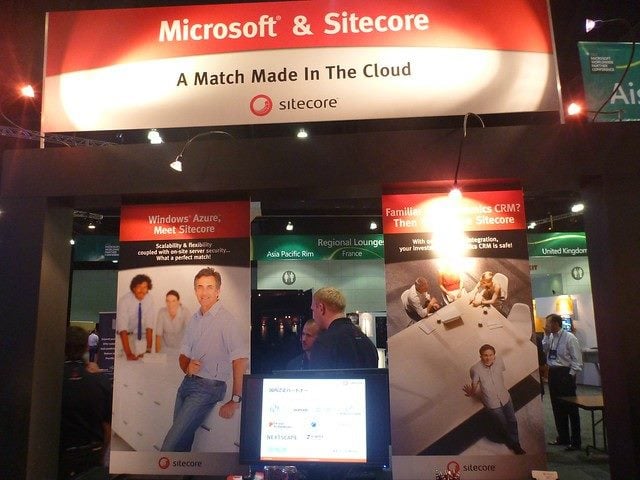The Gist
- Leadership shifts. Sitecore appoints Dave O'Flanagan as interim CEO, reflecting fluid leadership in the competitive DXP sector.
- Embracing SaaS. The move toward SaaS models and headless scenarios is a key trend in evolving DXP offerings.
- AI-driven innovation. Sitecore focuses on generative AI integration, showcasing the impact of AI on digital customer experiences.
The Digital Experience Platform (DXP) sector continues to be highly competitive with different providers jockeying for position to establish and protect their place in the market.
Subsequently, offerings continually evolve; for example, moving to a SaaS model to support composable and headless scenarios. DXP providers frequently make niche acquisitions and often change leadership, emphasizing the importance of choosing the right C-suite executive to drive market growth.
Let's take a look at some recent Sitecore leadership changes.
Sitecore Leadership Shift: O’Flanagan New CEO
At the beginning of March, Sitecore announced the departure of CEO Steve Tzikakis, with the appointment of Dave O’Flanagan as interim CEO. O’Flanagan is the former chief product officer and was formerly CEO at Boxever, which Sitecore acquired in 2021. At the same time, Darren Roos also takes over from Jonas Persson as chair of the board.

Sitecore did not share exact details behind the change. Tzikakis took over in September 2020 and successfully led Sitecore through a number of potentially complex acquisitions, as well as a transition to offering a SaaS-based platform.
Related Article: Sitecore Incorporates OpenAI Generative AI Into Software Solutions
What’s Behind the Change?
The Sitecore leadership change may be for personal reasons, disagreements about the strategic direction of the company or pressure from EQT, a majority shareholder. We don't know exactly. However, the move appears amicable with Tzikakis remaining an advisor during the transition and continuing as a shareholder.
Of course, there will be speculation. Tzikakis announcing his change on X describes the move as “an opportunity for me to take a pivotal change in my career, and pursue new opportunities.”
Of note: IFS, another software company where EQT is a majority shareholder, had a related leadership change. In January, IFS announced Mark Moffatt as CEO, replacing Roos as CEO; he has now been appointed as the chair of both IFS and Sitecore.
Related Article: From Generative AI to Accelerator: Unpacking Sitecore's Latest Product Announcements
A 'Safe Pair of Hands'
The Sitecore leadership move to appoint O’Flanagan as interim CEO seems positive. O’Flanagan is a safe pair of hands whose new position should help to establish continuity during a time of potential change. O’Flanagan has solid CEO experience at Boxever, the company he also founded.
I also observe that O’Flanagan is a product guy with the perspective to oversee and manage the evolution of a complex, technical platform with customer needs and strategic growth.
Related Article: Umbraco or Sitecore? Looking Through a Developer Lens
6 Key Items on Dave O’Flanagan’s To-Do list
While much of O’Flanagan’s immediate activity may be to continue to emphasize continuity and make reassurances, there will be quite a few other things on O’Flanagan’s plate.
Here’s what might be on his “to-do” list:
1. Help to Find — or Become — the Permanent CEO
O’Flanagan is described as interim CEO in Sitecore’s press release. Notably, Sitecore did not announce a chief product officer successor has been; O'Flanagan is listed as just the chief executive officer on Sitecore’s leadership pages. Of course, “interim” suggests there will be a hunt for a new CEO. However, it is possible that O’Flanagan will take on the position permanently, especially as there is no indication there is a hunt for a new person. It is also feasible that someone may have already been appointed, but it cannot be formally announced.
2. Possibly Gear Sitecore up for a Sale
There has been speculation that majority shareholder EQT is considering a sale for Sitecore and has been working with Goldman Sachs to work through different options and potential buyers. Despite various reports in June 2023, so far nothing has materialized. Inevitably there will be speculation that the change in leadership may be linked to a future transaction or sale.
Sitecore seems to be in a relatively healthy market position, with the private company reportedly valued around $2 billion. The owners may be looking to cash in. Despite this, a lead-up to a sale could involve internal changes to make the company a more attractive acquisition.
3. Defend Market Leadership Position
All the major sector analysts — Gartner, Forrester and IDC — place Sitecore into leadership or strong performing categories in various reports relating to Digital Experience Platforms and content marketing platforms. This also includes particular sub-sectors such as hybrid-headless CMS and personalization engines.
Sitecore will continue to vigorously defend its leadership position in what has become a competitive sector. It has a pretty well-oiled sales and marketing function that has become more of a global operation in recent years. Moreover, Sitecore has seen through extensive changes in the platform with new SaaS offerings, absorbed acquisitions into the platform and a progressive release schedule. That relentless pace of change is unlikely to slow down as Sitecore continues to drive growth.
4. Continue Product Evolution With AI at the Forefront
Generative AI is going to disrupt the world of digital customer experience, and it is starting to appear in DXP and CMS products. Last fall, Sitecore confirmed there will be “complete OpenAI integration” across all its solutions. It already announced some of the early manifestations of this, including translation capabilities within Sitecore XM Cloud and Dall-E image generation across the Sitecore Content Cloud bundle of products.
Under O’Flanagan's leadership, the continued integration of generative AI into the Sitecore platform has significantly shaped the product's evolution and will undoubtedly remain a key theme in the upcoming months.
There is already a hint of what this might look like. O’Flanagan has described how generative AI will also go beyond content generation and start to influence personalization and search experiences; he alluded to what amounts to a period of AI-driven innovation across the platform.
5. Move More Customers to SaaS
Last year, media misunderstandings regarding Sitecore's dedication to its PaaS solutions led O’Flanagan to confirm that Sitecore version 10.4, released in early 2024, will remain available until the end of 2027 and receive support until the end of 2030, with options for extended support thereafter. He also confirmed there is feature parity for SaaS and PaaS customers. Having this clarity is welcome and allows digital teams to be able to make the right investment decisions on what is still a premium product.
However, it seems there are still many customers yet to move to SaaS, and Sitecore would like many more to upgrade and probably at a faster rate. Marketing efforts and elements of product offerings will be designed to encourage more to do so, while the Accelerate program will continue; this is specifically designed to support platform customers to make the transition.
6. Eye Another Niche Acquisition
It’s been a while since Sitecore made an acquisition of a niche specialist. Never rule this out if the synergy is right and it adds to the platform and the expertise within the company. For example, an acquisition around generative AI is possible. Maybe even something more left field; for example, Sitecore entering the metaverse.
Watch the Sitecore Leadership Story
It’s possible that there could be more announcements on the back of the Sitecore leadership switch. It doesn't seem as if there will be a change in the direction of the product or Sitecore’s market position. O’Flanagan feels like a captain who will ensure the ship remains steady on its course. But, for sure, this could be one to watch.
